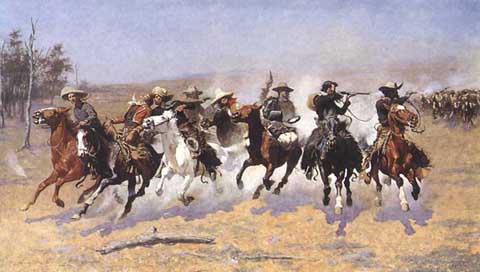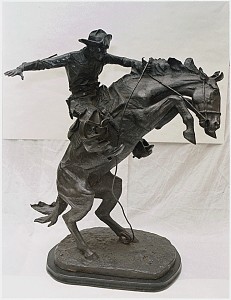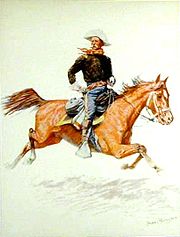
From Wikipedia:
“Frederic Sackrider Remington (October 4, 1861 – December 26, 1909) was an American painter, illustrator, sculptor, and writer who specialized in depictions of the Old American West, specifically concentrating on the last quarter of the 19th century American West and images of cowboys, American Indians, and the U.S. Cavalry.
“Remington was born in Canton, New York …. attended the art school at Yale University, the only male in the freshman year. However, he found that football and boxing were more interesting than the formal art training, particularly drawing from casts and still life objects….
 “Living off his inheritance and modest work income, Remington refused to go back to art school and instead spent time camping and enjoying himself. At nineteen, he made his first trip west, going to Montana, at first to buy a cattle operation then a mining interest but realized he did not have sufficient capital for either. In the Ol’ West of 1881, he saw the vast prairies, the quickly shrinking buffalo herds, the still unfenced cattle, and the last major confrontations of U.S. Cavalry and native American tribes, scenes he had imagined since his childhood. He also hunted grizzly bears with Montague Stevens in New Mexico in 1895….
“Living off his inheritance and modest work income, Remington refused to go back to art school and instead spent time camping and enjoying himself. At nineteen, he made his first trip west, going to Montana, at first to buy a cattle operation then a mining interest but realized he did not have sufficient capital for either. In the Ol’ West of 1881, he saw the vast prairies, the quickly shrinking buffalo herds, the still unfenced cattle, and the last major confrontations of U.S. Cavalry and native American tribes, scenes he had imagined since his childhood. He also hunted grizzly bears with Montague Stevens in New Mexico in 1895….
 “In 1883, Remington went to rural Peabody, Kansas, to try his hand at the booming sheep ranching and wool trade, as one of the “holiday stockmen”, rich young Easterners out to make a quick killing as ranch owners. He invested his entire inheritance but Remington found ranching to be a rough, boring, isolated occupation which deprived him of the finer things of Eastern life, and the real ranchers thought him a lazy playboy. Remington continued sketching but at this point his results were still cartoonish and amateurish. After less than a year, he sold his ranch and went home.
“In 1883, Remington went to rural Peabody, Kansas, to try his hand at the booming sheep ranching and wool trade, as one of the “holiday stockmen”, rich young Easterners out to make a quick killing as ranch owners. He invested his entire inheritance but Remington found ranching to be a rough, boring, isolated occupation which deprived him of the finer things of Eastern life, and the real ranchers thought him a lazy playboy. Remington continued sketching but at this point his results were still cartoonish and amateurish. After less than a year, he sold his ranch and went home.
“In 1886, Remington was sent to Arizona by Harper’s Weekly on a commission as an artist-correspondent to cover the government’s war against Geronimo. Although he never caught up with Geronimo, Remington did acquire many authentic artifacts to be used later as props, and made many photos and sketches valuable for later paintings. He also made notes on the true colors of the West, such as “shadows of horses should be a cool carmine & Blue”, to supplement the black and white photos. Ironically, art critics later criticized his palette as “primitive and unnatural” even though it was based on actual observation.
“Later that year, Remington received a commission to do eighty-three illustrations for a book by Theodore Roosevelt, Ranch Life and the Hunting Trail, to be serialized in The Century Magazine before publication. The twenty-five year old Roosevelt had a similar Western adventure to Remington, losing money on a ranch in North Dakota the previous year but gaining experience which made him an “expert” on the West. The assignment gave Remington’s career a big boost and forged a lifelong connection with Roosevelt.
 “Around this time, Remington made a gentleman’s agreement with Harper’s Weekly, giving the magazine an informal first option on his output but maintaining Remington’s independence to sell elsewhere if desired. As a bonus, the magazine launched a massive promotional campaign for Remington, stating that “He draws what he knows, and he knows what he draws.” Though laced with blatant puffery (common for the time) claiming that Remington was a bona fide cowboy and Indian scout, the effect of the campaign was to raise Remington to the equal of the era’s top illustrators.
“Around this time, Remington made a gentleman’s agreement with Harper’s Weekly, giving the magazine an informal first option on his output but maintaining Remington’s independence to sell elsewhere if desired. As a bonus, the magazine launched a massive promotional campaign for Remington, stating that “He draws what he knows, and he knows what he draws.” Though laced with blatant puffery (common for the time) claiming that Remington was a bona fide cowboy and Indian scout, the effect of the campaign was to raise Remington to the equal of the era’s top illustrators.
“Through the 1890’s, Remington took frequent trips around the U.S., Mexico, and abroad to gather ideas for articles and illustrations, but his military and cowboy subjects always sold the best, even as the Old West was playing out. Gradually, he transitioned from the premiere chronicler-artist of the Old West to its most important historian-artist.
“Frederic Remington died after an emergency appendectomy led to peritonitis on December 26, 1909. His extreme obesity (weight nearly 300 lbs.) had complicated the anesthesia and the surgery, and chronic appendicitis was cited in the post-mortem examination as an underlying factor in his death.”
Check out the Frederic Remington Art Museum in New York.
